Create WhatsApp messages
This guide shows you how to build, format, test, and manage WhatsApp messages in Bloomreach Engagement. For background info about message types and costs, check the main WhatsApp docs.
Note
WhatsApp is only available in some Bloomreach Engagement packages. Contact your CSM or CS team to start using WhatsApp.
Choose your message format
WhatsApp offers 5 interactive message formats. Choose the one that fits your goal and audience needs.
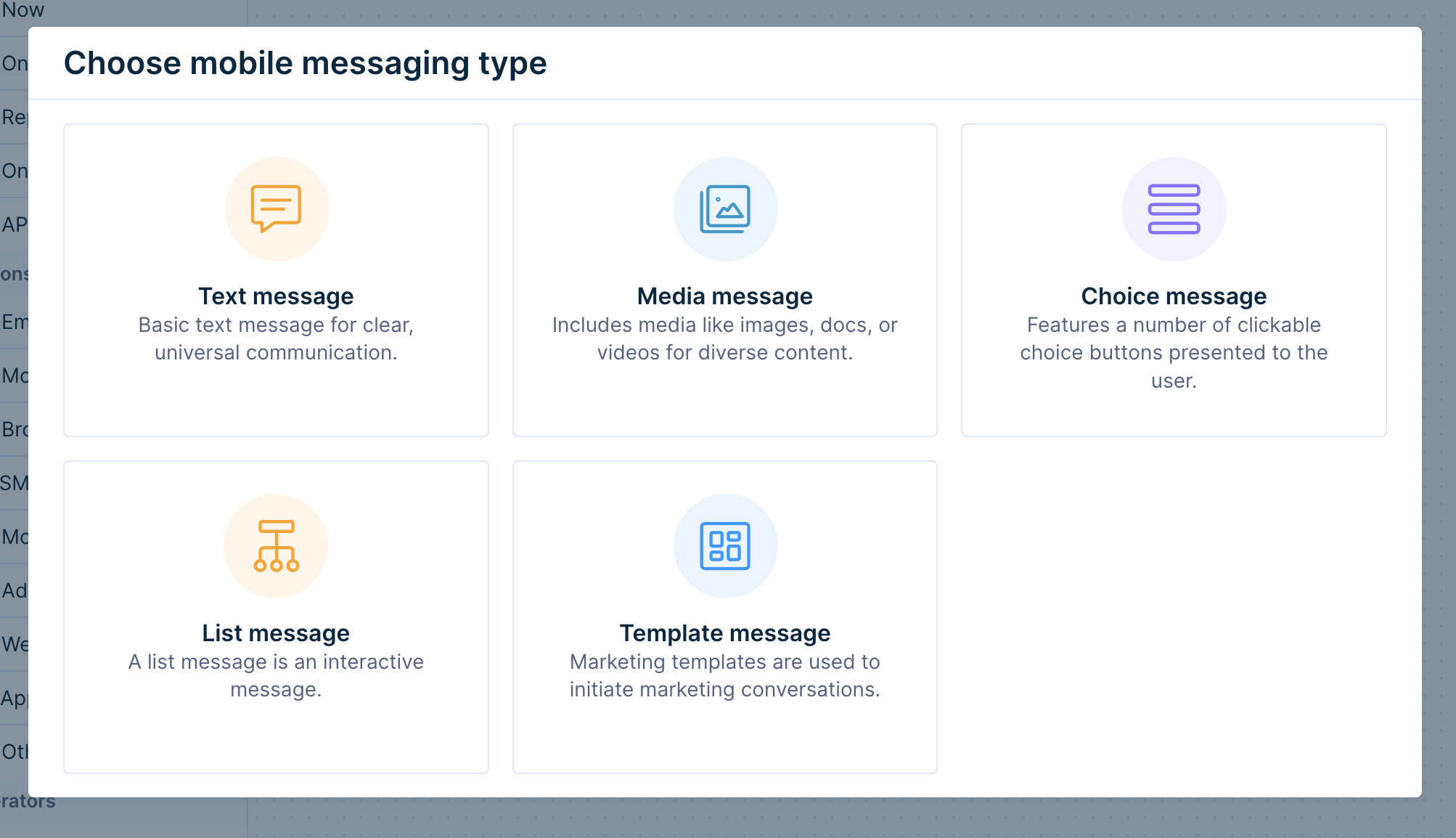
Text message
Send simple text-only messages up to 4,096 characters.
When to use
Quick updates, simple notifications, or personal messages.
How to set up
Add your content in the Message field.
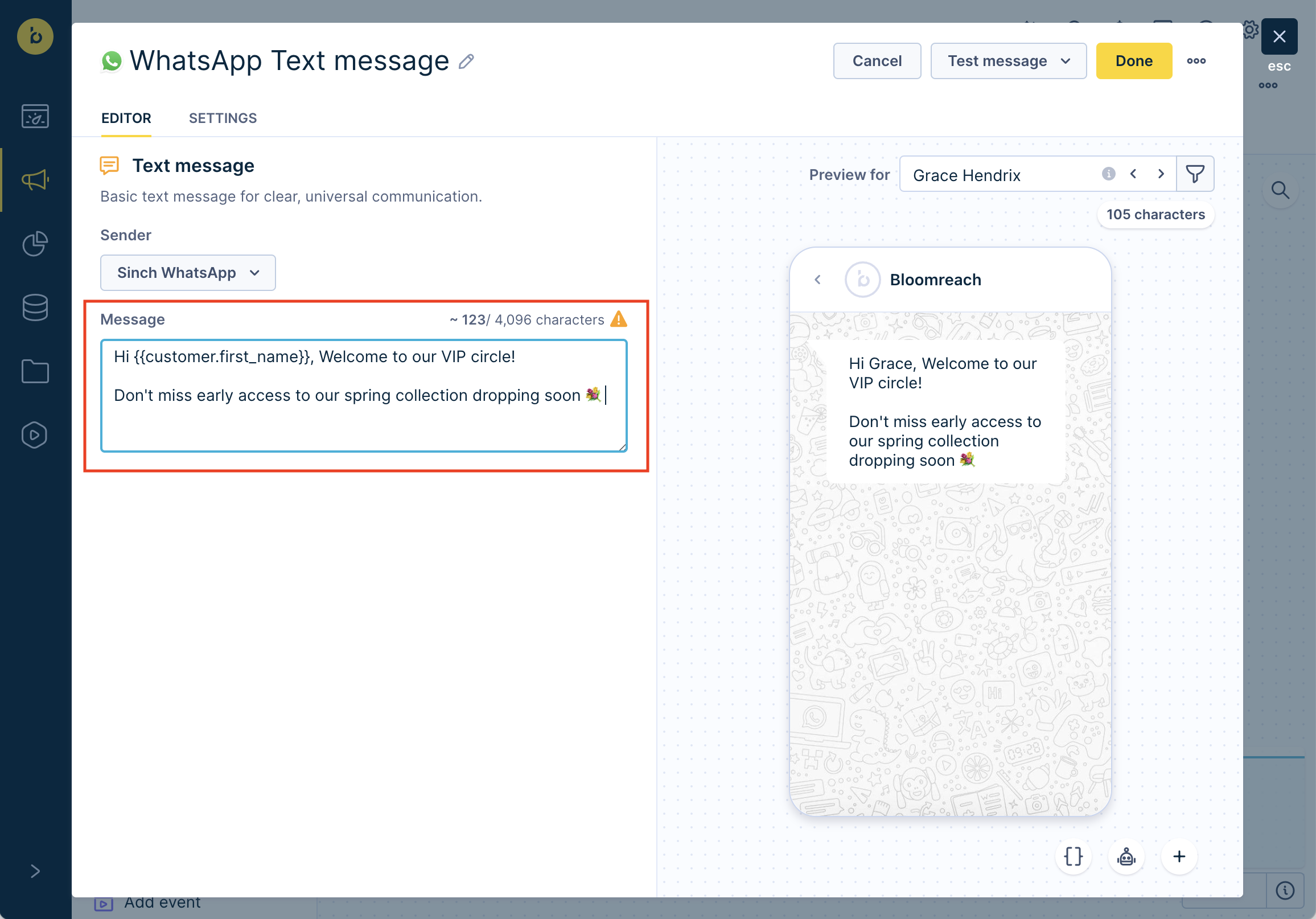
Media message
Share images, videos, audio files, or documents with your text.
When to use
Product showcases, tutorials, receipts, or rich content experiences..
File limits
- Images: JPEG or PNG with a maximum size of 5MB.
- Videos: MP4 or 3GPP with a maximum size of 16MB.
- Documents: Any valid document MIME type with a maximum size of 100MB.
How to set up
In the Your media field, click + to select a file from the Asset Manager or paste a public URL.
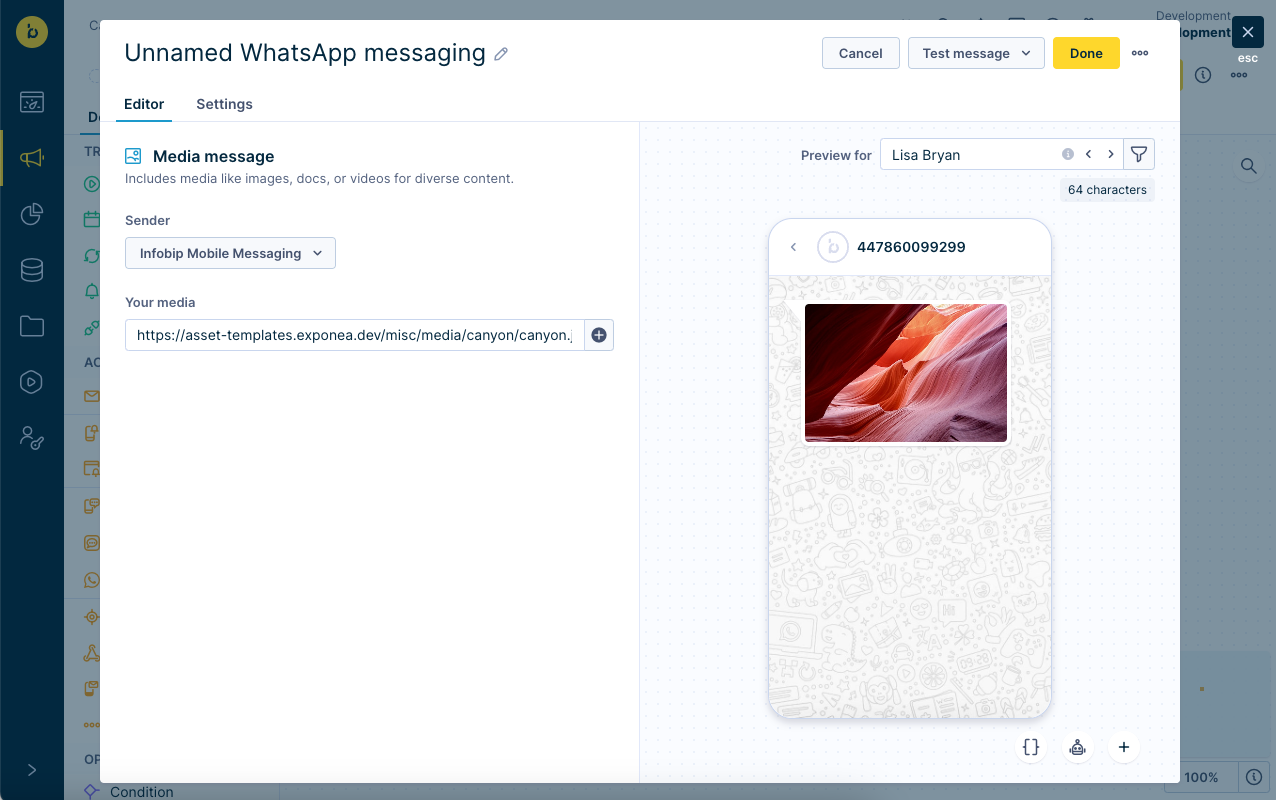
Choice message
Add up to 10 quick-reply buttons below your message. If you add more than 3 buttons, they'll show as a dropdown menu.
When to use
- Guide customers through options.
- Collect specific responses.
- Let people pick categories.
- Limit answers to certain choices.
How to set up
Write your message, then customize the button text in the Choices fields.
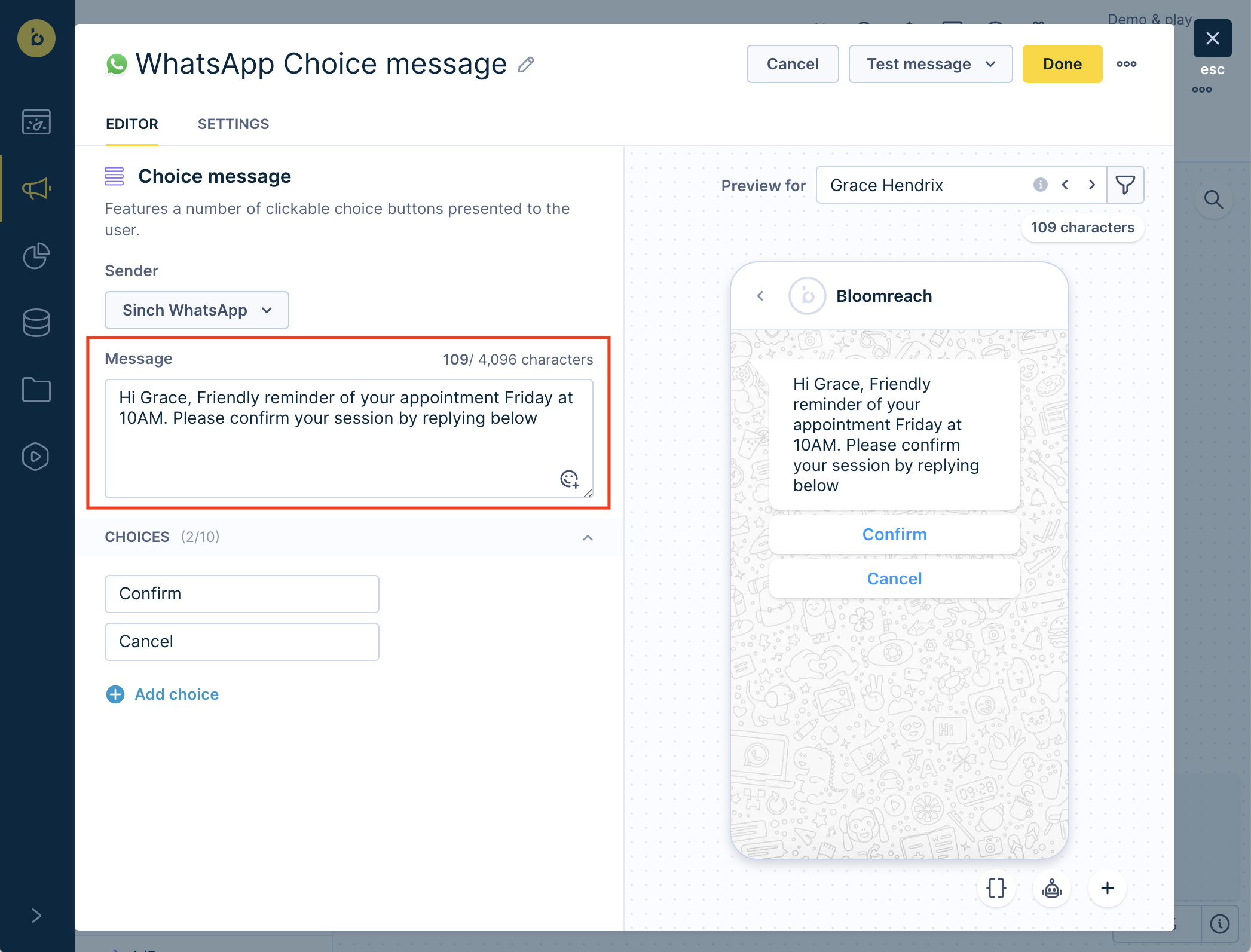
List message
Create an interactive menu with up to 10 selectable options.
When to use
- Show product categories or items.
- Create surveys with many answer choices.
- Surveys when the answer set is long or hierarchical.
- Display booking times or appointment slots.
- Build browsable menus and catalogs.
How to set up
Fill in the Title and Description fields, then add your options in the List items section.
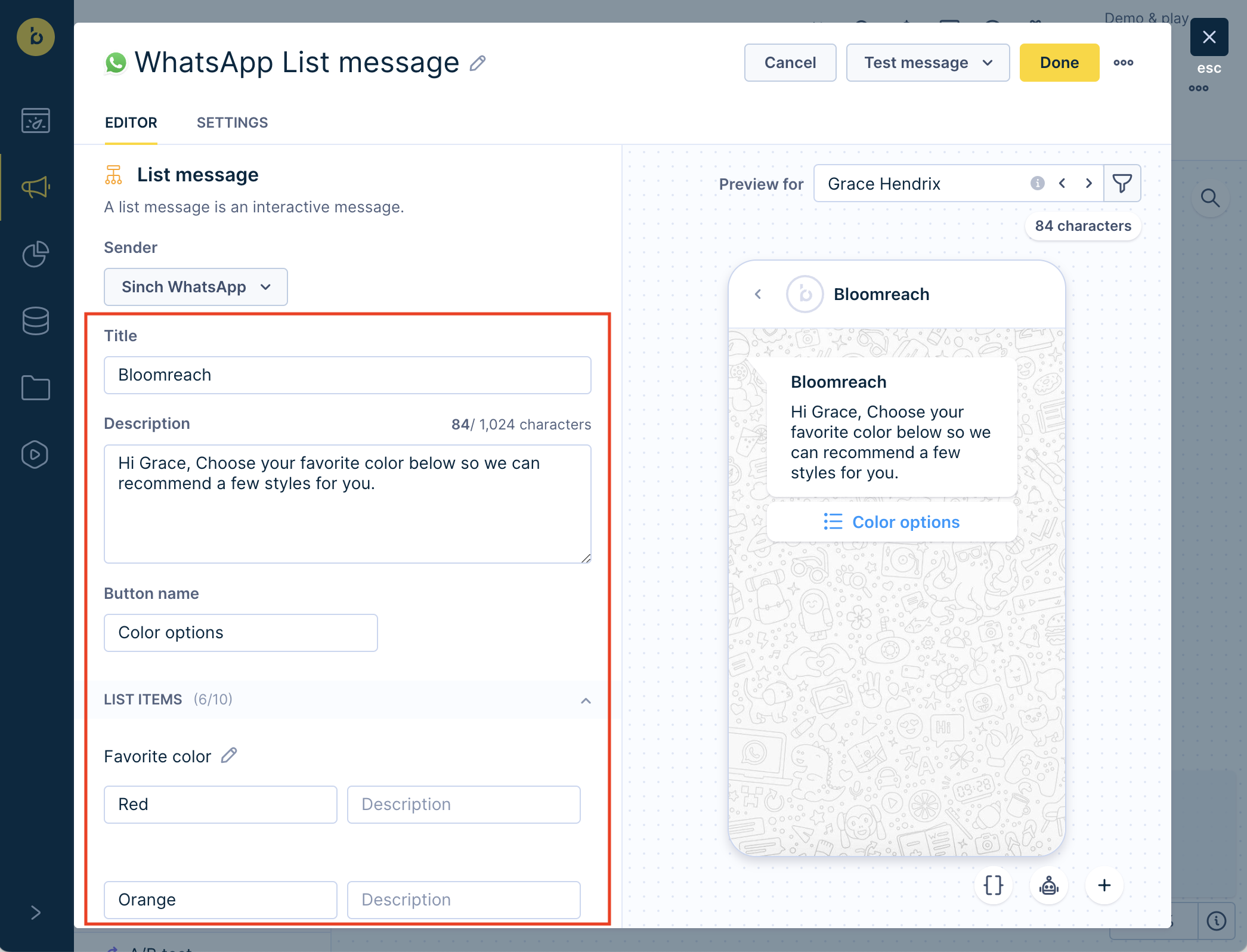
Template message
Use pre-approved message formats that follow WhatsApp's guidelines. These messages let you start conversations with customers.
Template message restrictions for US numbers
Since April 1, 2025, template messages are no longer supported for US phone numbers (+1). Use MMS or RCS channels instead or get your customers to message you first.
When to use
First contact with customers or structured business communications.
How to set up
Select from your approved templates in the Selected template field, then customize the content.
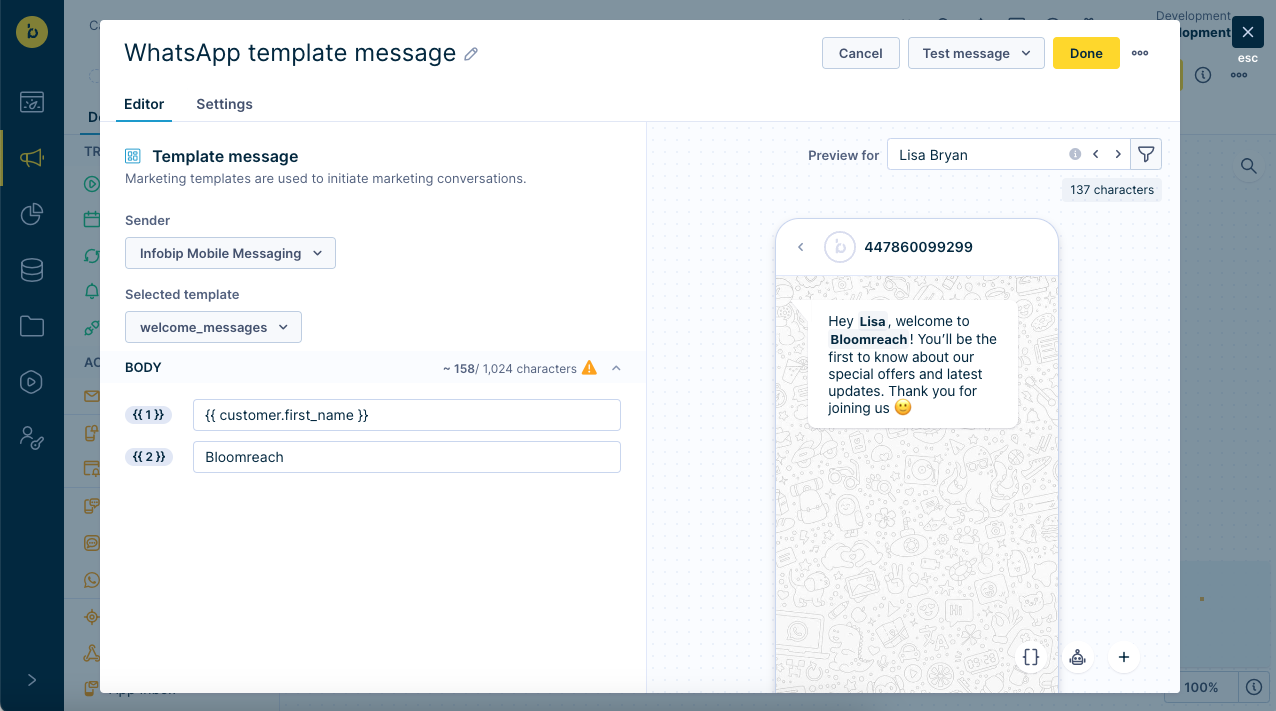
Build your message
Once you select your message format, follow these steps to create your WhatsApp message.
-
Go to Campaigns > Scenarios and create a new scenario.
-
Under the Design tab, add the WhatsApp node.
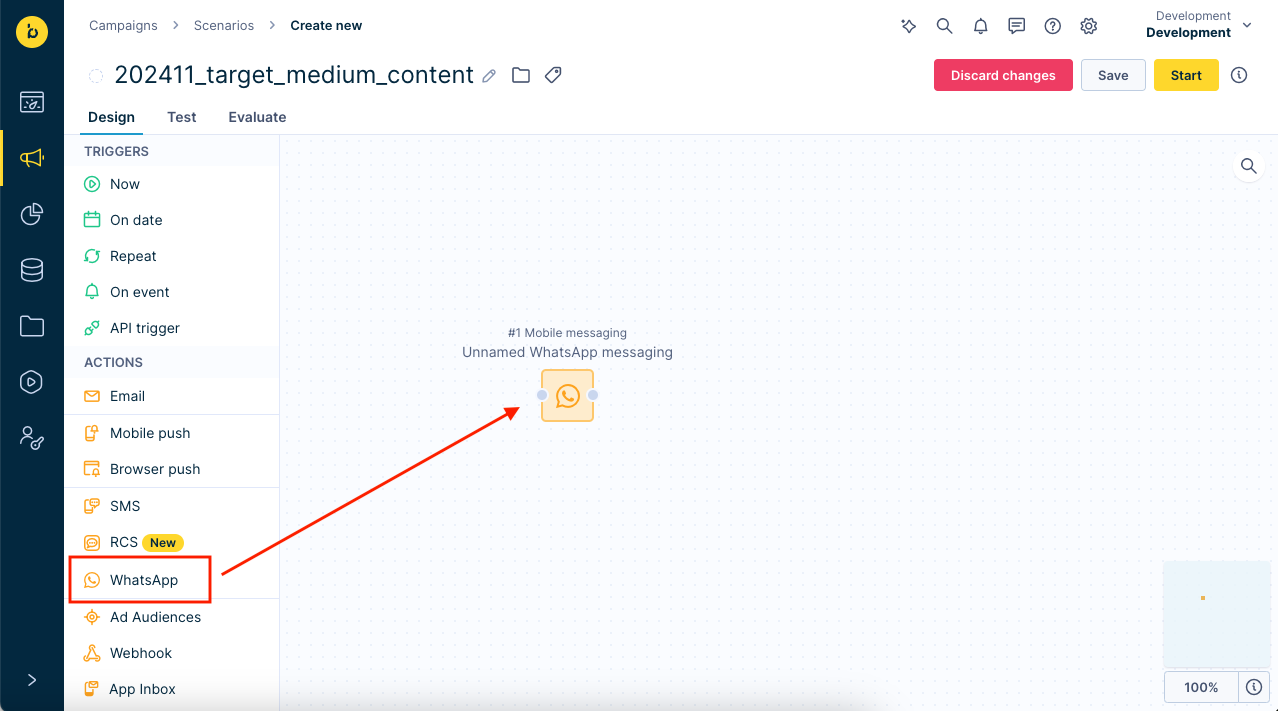
-
Double-click the WhatsApp node.
-
Choose the message type.
-
Select a provider in the Sender dropdown if you don't want to use the default.
-
Customize the message. For details on each message type, see below.
- Personalize the message with Jinja and emojis.
- Use the Loomi copy generator if you need writing help.
- Check the dynamic character counter to stay within limits.
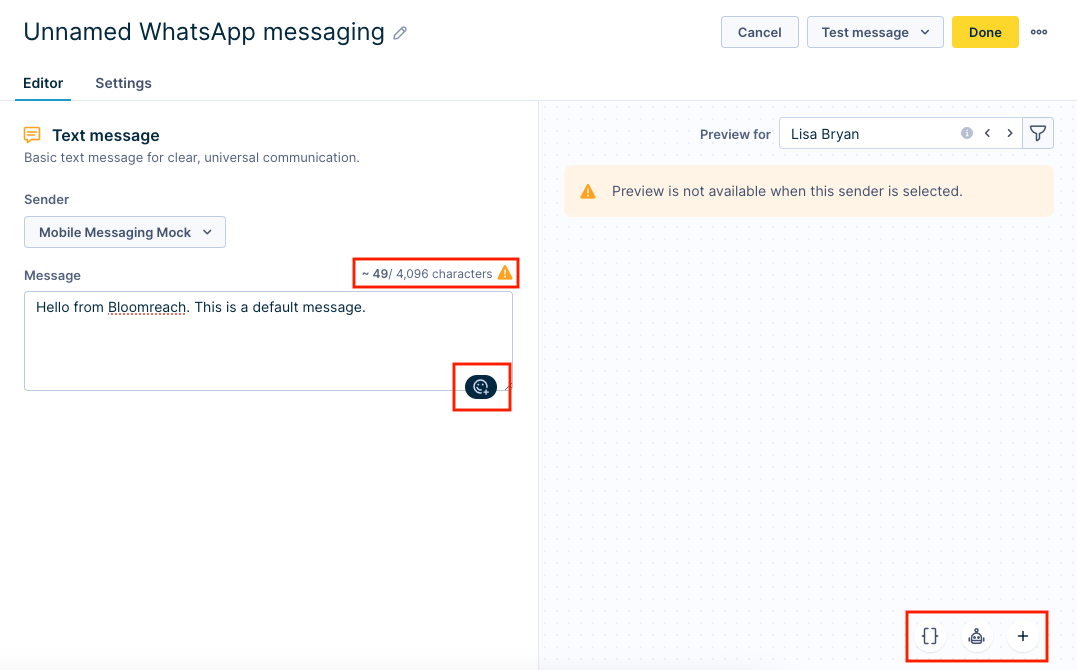
The customer's phone attribute is used as the recipient's phone number.

Work with templates
Create templates
To create a new WhatsApp template, contact your CSM. You can't do this in the Bloomreach Engagement app.
Submit templates
You need to submit message templates to Meta for approval. We do this by asking you to fill out the WhatsApp Registration Template form. The Mobile Expert submits templates for approval. You need a new template submission for:
- New templates
- Different languages
- Template edits
Template categories
The template must be from one of the following categories:
- Transactional messages: Personal finance update, account update, alert update, appointment update, issue resolution, payment update, reservation update, shipping update, ticket update, transportation update.
- Non-transactional messages: No predefined categories.
Template requirements
- All parameters
{{ }}need to be filled out before sending the message. - All parameters must match what you submitted. If the example you gave to Meta was a URL, it has to be a URL.
- Meta automatically checks if the parameter type matches what you submitted. If it doesn't recognize it, it goes through automatic review, which takes a couple of days.
Example messages
"Dear {{1}}, You have items in your shopping cart and haven't finished your purchase. If you want us to take you to your shopping cart, type CART as a response to this message."
"We’re down to the last 3 pieces of an item you have saved in your favorites! Get in there before it’s gone. Check it out at bloomreach.com/favorites"
Limitations
All parameters must be filled out with the same data structure as submitted. For example, if the parameter was submitted in a URL form, it must be a URL.
Format your messages
WhatsApp lets you style text within your messages.
Important
Bloomreach Engagement doesn't preview the text formatting. You can only see the formatting inside your message after you send the campaign.
| Message Formatting | Example |
|---|---|
| • Bulleted list | - Text |
| 1. Numbered list | 1. Text |
| | Block quote | > Text |
Inline code | ` symbol at the start and end of the text |
| Bold | - or ** asterisks on both sides of the text |
| Italic | _ on both sides of the text |
| ~ or ~~ on both sides of the text | |
| Monospace | Three backticks (`) on both sides of the text |
Test your messages
Always test your messages before sending them to customers. This helps you catch issues and see how messages look on real devices.
-
Click Test message in the message editor.
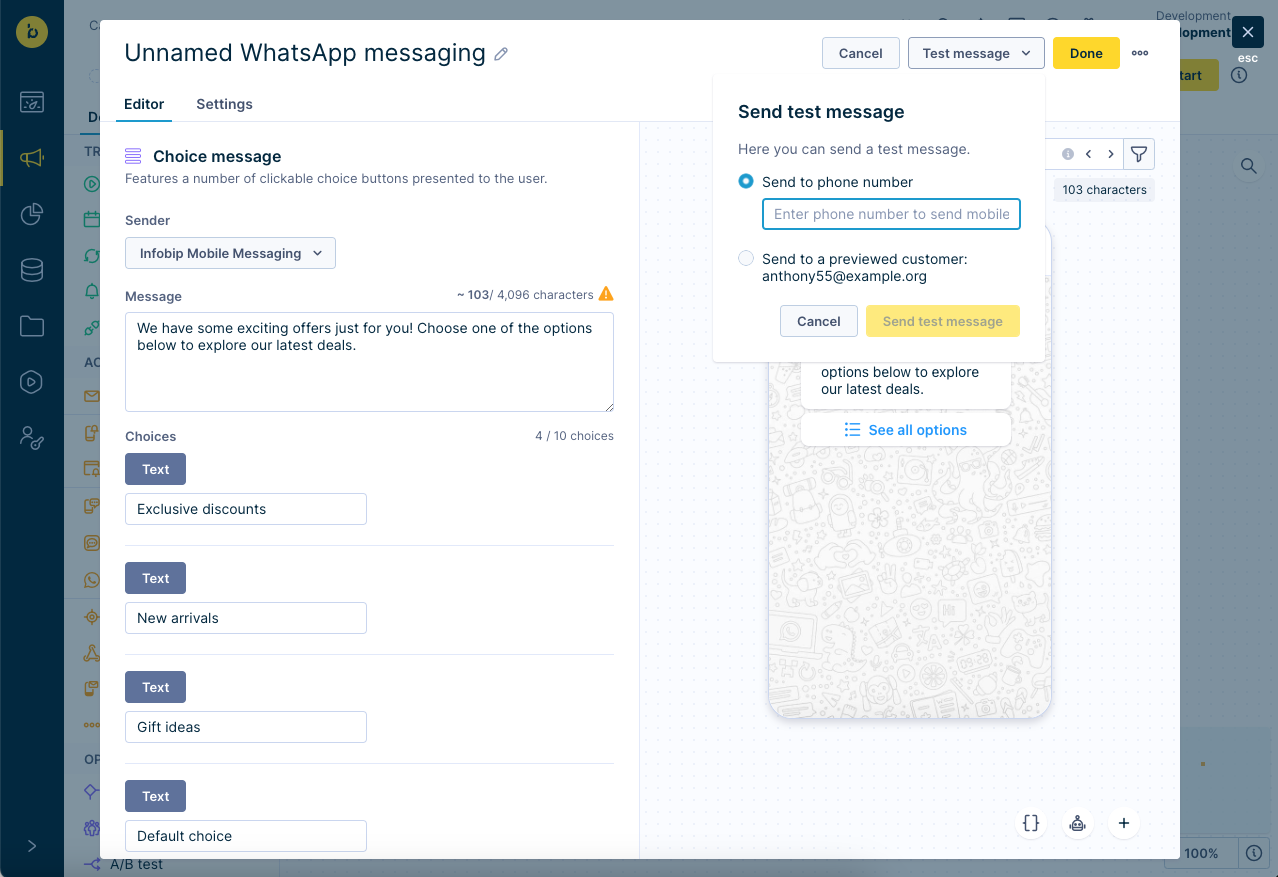
-
Enter a test phone number (include country code).
-
Check how the message appears on the test device.
-
Make changes if needed and test again.
Important
You can only test template messages. Other message types don't support testing, so double-check your content before sending.
Get customer consent
You need permission before sending WhatsApp messages to customers. This protects both you and your customers, plus it's required by law in most places.
What you need
Before sending any WhatsApp message, make sure you have:
- The customer's phone number.
- Your business name clearly stated.
- Explanation of what messages you'll send.
- Clear opt-in from the customer to receive messages.
Avoid spam, misleading content, or unexpected messaging. Transparency is key.
First message rules
Your very first WhatsApp message to each customer must include opt-out instructions. Use phrases like:
- Send STOP to opt out
- Reply STOP to unsubscribe
- Include a link to your unsubscribe page
For subscription messages: Add "To opt out at any time, reply with STOP" to your welcome message.
Use existing consent
Your use of the WhatsApp communication channel must comply with all WhatsApp policies.
You don't need separate WhatsApp consent if you already have SMS or RCS permission. You can use existing consent when you:
- Have the customer's mobile phone number.
- Got permission to send messages through any channel.
- Follow all relevant laws.
- Provide required notices and permissions.
- Offer separate opt-out options for each messaging channel.
Important
Always offer separate opt-out options for each messaging channel.
Collect consent
Select the method that works best for your business:
- SMS: Text customers asking for WhatsApp permission.
- Website forms: Add WhatsApp checkboxes to sign-up forms.
- Phone calls: Ask during customer service calls.
- In-person: Collect consent at stores or events.
- QR codes: Let customers scan to start conversations.
- wa.me links: Direct customers to chat with your business.
Review WhatsApp's opt-in guidance for more tips.
Set up consent categories
Use Consent management to create specific WhatsApp consent categories so customers can manage their preferences:
- Go to Settings > Project settings.
- Under Campaigns, go to Privacy management > Consents.
- Click + Add consent.
- Select the relevant consent category when creating WhatsApp campaigns.
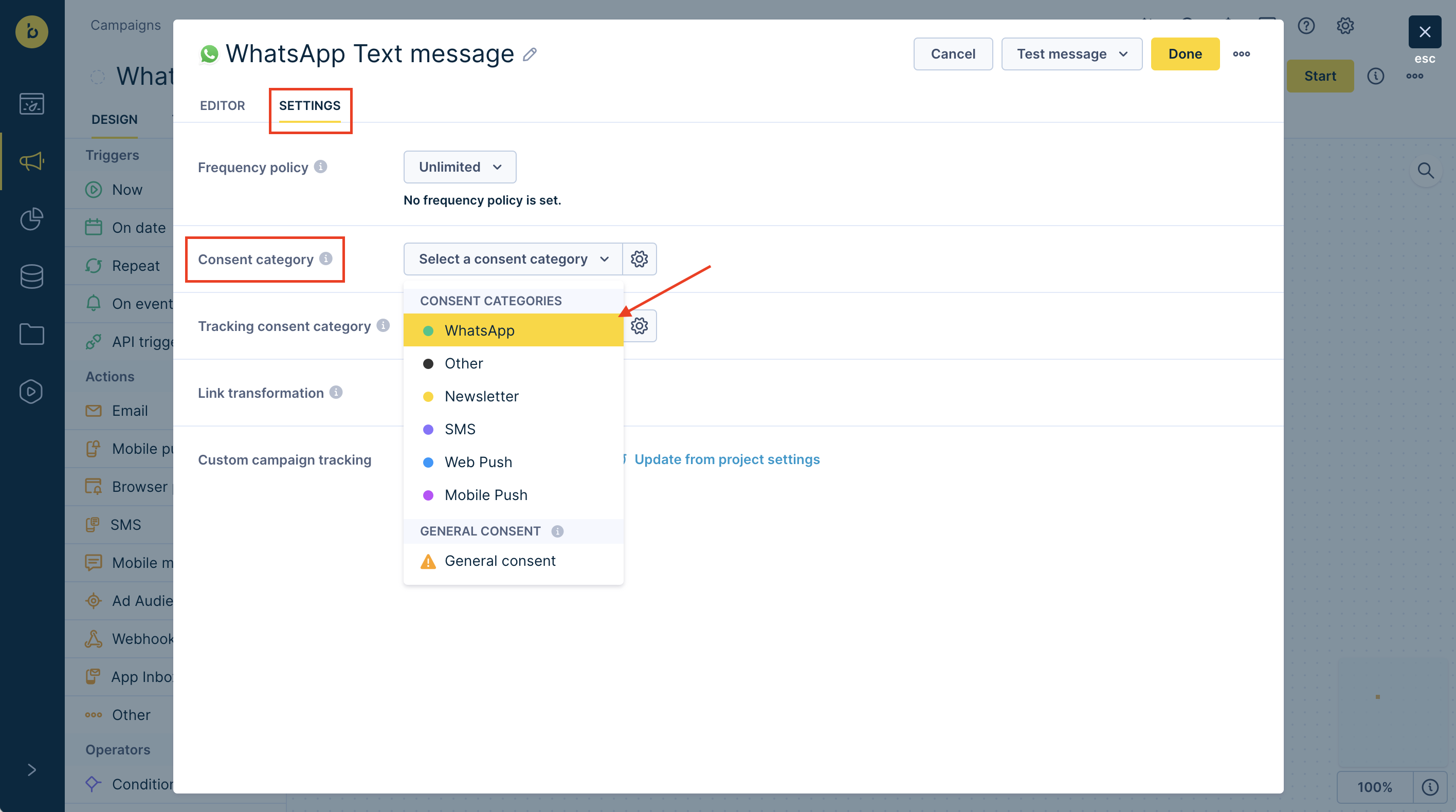
Track clicks in WhatsApp messages
Understanding how customers interact with your WhatsApp messages helps you improve future campaigns.
What gets tracked
Bloomreach Engagement tracks clicks on URLs when:
- The link sits directly in your message text (not in CTA buttons).
- The link uses link shortener.
What doesn't get tracked
- Template message CTA button clicks (due to platform limits).
- Links that don't use link shortener.
Workaround for CTA buttons
Add UTM parameters to your button links. Then look for matching
session_startevents to identify clicks.
Track button interactions
For free-form messages (like choice messages), button clicks show up in campaign events with:
- Status:
incoming_message - Message: The exact button text the customer clicked
For example, if someone clicks a "Track order" button, you'll see an event with the message "Track order."
Two-way messaging
For details, read:
Updated 3 months ago
